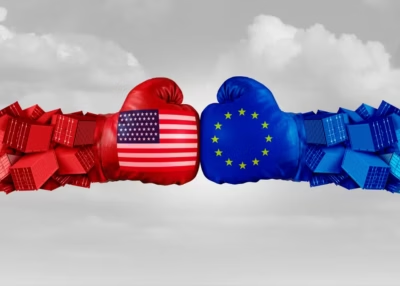
Lemonde
The United States and European Union have struck a major trade agreement, bringing an end to a months-long standoff between two of the world’s most significant economic powers.
Following make-or-break negotiations in Scotland between US President Donald Trump and European Commission President Ursula von der Leyen, the two leaders announced a sweeping deal that imposes a 15% blanket tariff on all EU goods entering the US. The agreed rate is half of the 30% import tax Trump had threatened to enforce starting Friday.
As part of the agreement, Trump said the 27-nation bloc will now open its markets to certain American exports, allowing them to enter tariff-free. Von der Leyen praised the agreement, calling it a stabilising move for both sides, which together account for nearly one-third of global trade.
Trump has consistently used tariff threats as leverage to reshape global trade and reduce the US trade deficit. Alongside the EU, his administration has also finalised tariff deals with other major economies, including the United Kingdom, Japan, Indonesia, and Vietnam—though he has yet to achieve his stated goal of “90 deals in 90 days.”
Sunday’s breakthrough was announced after closed-door discussions at Trump’s Turnberry golf course in South Ayrshire, during his ongoing five-day visit to Scotland.
“We have reached a deal. It’s a good deal for everybody,” Trump said following the talks. “It’s going to bring us closer together.”
Von der Leyen described the agreement as a “huge deal” after what she called “tough negotiations.”
Under the terms of the deal, Trump said the EU has committed to increasing investment in the US by $600 billion (£446 billion), purchasing hundreds of billions of dollars’ worth of American military hardware, and spending $750 billion on US energy exports.
Von der Leyen noted that the energy component of the agreement—including liquified natural gas, oil, and nuclear fuel—would help reduce Europe’s dependence on Russian power sources.
“I want to thank President Trump personally for his personal commitment and his leadership to achieve this breakthrough,” she said. “He is a tough negotiator, but he is also a dealmaker.”
Despite the breakthrough, Trump confirmed that the 50% global tariff on steel and aluminium imports would remain in effect.
The agreement offers political wins on both sides. For the EU, the 15% tariff is less damaging than the previously threatened 30%, though it is higher than the 10% rate secured by the UK. It matches the terms of Japan’s recent deal with the US.
For Washington, the deal is expected to generate an estimated $90 billion in tariff revenue based on last year’s trade volumes, in addition to the hundreds of billions in promised European investment.
Bilateral trade in goods between the EU and US totalled around $975.9 billion last year. The US imported roughly $606 billion in goods from the EU while exporting about $370 billion, creating a trade deficit that Trump has long criticised. He argues such deficits mean the US is “losing” in global trade.
Had Trump followed through with his initial 30% tariff threat, a wide range of European goods—including Spanish pharmaceuticals, Italian leather, German electronics, and French cheese—would have faced steep import duties. In response, the EU had threatened retaliatory tariffs on US exports such as car parts, Boeing aircraft, and beef.
The timing of the agreement is notable. British Prime Minister Keir Starmer is scheduled to meet Trump at Turnberry on Monday for his own round of trade discussions. Trump is then expected in Aberdeen on Tuesday, where his family is preparing to open a third golf course.
Trump and his sons are set to participate in a ribbon-cutting ceremony to inaugurate the new fairway, continuing a high-profile visit that has mixed politics, diplomacy, and business.




